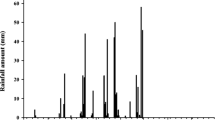Abstract
Nodulating bacteria from the family Rhizobiaceae are common in the semi-arid tropics around the world. The Brazilian semi-arid region extends over 95 million hectares of which only 3% is suitable for irrigation, therefore leaving an immense dryland area to be exploited by peasant farmers, who often lack appropriate technologies for sustainable management. Cowpea is an important crop in this area, representing the staple protein source for human nutrition. This work aimed to identify rhizobial strains capable of guaranteeing sufficient nitrogen derived from biological fixation for cowpea cultivated in dryland areas, evaluating not just efficiency but also the ecological parameters of competitiveness and survival in the soil. Grain yield and nodulation parameters showed that strain BR 3267 is capable of establishing efficient nodulation, improving both yield and total N accumulated in grain. Cowpea inoculated with strain BR 3267 showed grain productivity similar to plants receiving 50 kg of N per hectare, which is the amount of fertilizer commonly used in the north-east region. These characteristics associated with previously determined ecological properties makes strain BR 3267 an important resource for the optimization of biological nitrogen fixation in cowpea in the dryland areas of the semi-arid tropics. Data on the dynamics of rhizobial populations in such areas have shown that (1) the naturalized rhizobium population is very small and, by themselves, do not promote proper nodulation and, (2) the inoculant rhizobia do not persist between crops. Such characteristics represent an opportunity for the introduction of superior rhizobia strains, such as BR 3267, during the cowpea crop.





Similar content being viewed by others
References
Athar M, Johnson DA (1996) Influence of drought on competition between selected Rhizobium meliloti strains and naturalized soil rhizobia in alfalfa. Plant Soil 184:231–241
Evans J, Gregory A, Dobrowolski N, Morris SG, O'Connor GE, Wallace C (1996) Nodulation of field-grown Pisum sativum and Vicia faba: competitiveness of inoculant strains of Rhizobium leguminosarum bv. viciae determined by an indirect, competitive ELISA method. Soil Biol Biochem 28:247–255
Freire Filho FR, Ribeiro VQ, Barreto PD, Santos CAF (1999) Melhoramento Genético de Caupi (Vigna unguiculata (L) Walp) na Região do Nordeste. In: Queiróz MA de, Goedet CO, Ramos SRR (eds) Recursos Genéticos e Melhoramento de Plantas para o Nordeste brasileiro—Petrolina—Pe: Embrapa Semi-Árido/ Brasília—DF: Embrapa Recursos Genéticos e Biotecnologia. Available at http//www.cpatsa.embrapa.br. ISBN85-7405-001-6
Hirsch PR (1996) Population dynamics of indigenous and genetically modified rhizobia in the field. New Phytol 133:159–171
Mårtensson AM, Gustafsson JG (1985) Competition between Rhizobium trifolii strains for nodulation, during growth in a fermenter, and in soil based inoculants, studied by ELISA. J Gen Microbiol 131:3077–3082
Martins LMV (1996) Aspectos ecológicos e fisiológicos de rizóbio de caupi (Vigna unguiculata (L.) Walp) obtidos a partir de solos de diferentes regiões edafoclimáticas do Estado Pernambuco. MSc Thesis, Universidade Federal Rural do Rio de Janeiro, Seropédica, Brazil
Martins LMV, Neves MCP, Rumjanek NG (1997) Growth characteristics and symbiotic efficiency of rhizobia isolated from cowpea nodules of the north-east region of Brazil. Soil Biol Biochem 29:1005–1010
Mpepereki S, Wollum AG, Makonese F (1996) Diversity in symbiotic specificity of cowpea indigenous to Zimbabwean soils. Plant Soil 1862:167–171
Ribeiro JRA (1999) Aplicação da técnica de ELISA no estudo ecológico de Rhizobium sp. isolados de nódulos de caupi (Vigna unguiculata) originárias da região Nordeste brasileira. MSc Thesis, Universidade Federal do Rio de Janeiro, Rio de Janeiro, Brazil
Simon T, Kálalová S, Petrzik K (1996) Identification of Rhizobium strains and evaluation of their competitiveness. Folia Microbiol 41:65–72
Singleton PW, Bohlool BB, Nakao PL (1992) Legume response to rhizobial inoculation in the tropics: myths and realities. In: Lal R, Sanchez PA (eds) Myths and science of soils of the tropics. Soil Science Society of America/American Society of Agronomy, Madison, Wis., pp 135–155
Toro N (1996) Nodulation competitiveness in the Rhizobium-legume symbiosis. W J Microbiol Biotechnol 12:157–162
Vincent JM (1970) A manual for the practical study of root-nodule bacteria. International Biological Program (IPB) handbook, no.15. Blackwell Scientific, Oxford
Woomer P, Asano W, Bohlool BB (1992) Predicting the persistence of introduced Bradyrhizobium japonicum in tropical soils. In: Mulongoy K, Gueye M, Spencer DSC (eds) Biological nitrogen fixation and sustainability of tropical agriculture. Proceedings of the fourth international conference of the African association for biological nitrogen fixation (AABNF), Ibadan, Nigeria, 24–28 September 1990. Wiley, Chichester, pp 235–243
Xavier GR, Martins LMV, Neves MCP, Rumjanek NG (1998) Edaphic factors as determinants for the distribution of intrinsic antibiotic resistance in a cowpea rhizobia population. Biol Fertil Soils 27:386–392
Zilli JE (2001) Caracterização e seleção de estirpes de rizóbio para inoculação de caupi (Vigna unguiculata (L) Walp) em solos do Cerrado. MSc Thesis, Universidade Federal Rural do Rio de Janeiro, Seropédica, Brazil
Zilli JE, Ferreira EPB, Neves MCP, Rumjanek NG (1999) Efficiency of fast-growing rhizobia capable of nodulating cowpea. An Acad Bras Cien 71:553-560
Acknowledgements
We are grateful to Dr Robert Boddey, Dr Sebastião M. Souto and Dr Marcelo Grandi for reading the manuscript and for critical suggestions, and Rojane Chapeta Peixoto for technical assistance and collaboration. We would also like to thank the Brazilian Research Council (CNPq) and PRODETAB through project 01.0.98.031 for financial support.
Author information
Authors and Affiliations
Corresponding author
Rights and permissions
About this article
Cite this article
Martins, L.M.V., Xavier, G.R., Rangel, F.W. et al. Contribution of biological nitrogen fixation to cowpea: a strategy for improving grain yield in the semi-arid region of Brazil. Biol Fertil Soils 38, 333–339 (2003). https://doi.org/10.1007/s00374-003-0668-4
Received:
Accepted:
Published:
Issue Date:
DOI: https://doi.org/10.1007/s00374-003-0668-4




